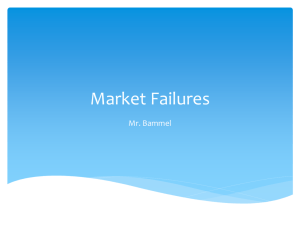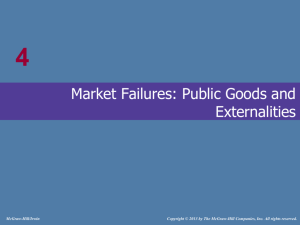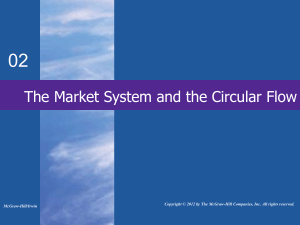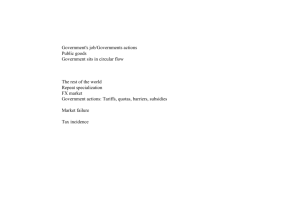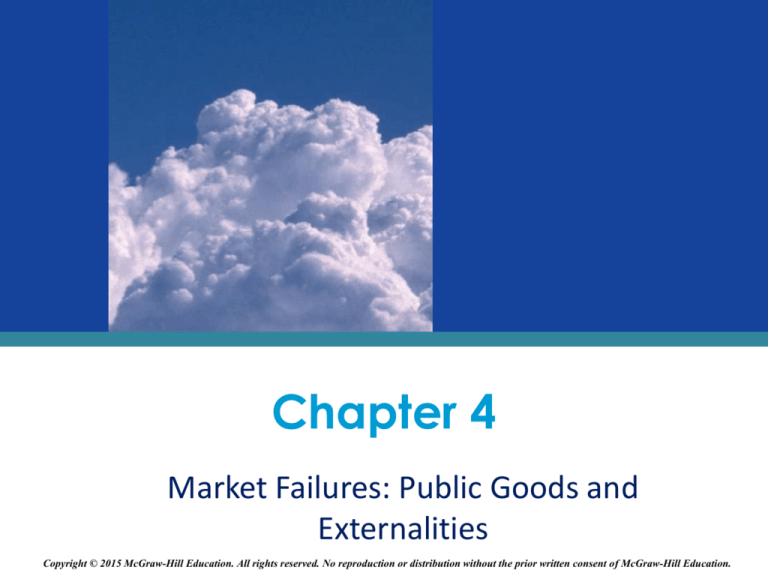
Chapter 4
Market Failures: Public Goods and
Externalities
Copyright © 2015 McGraw-Hill Education. All rights reserved. No reproduction or distribution without the prior written consent of McGraw-Hill Education.
Efficiently Functioning Markets
• Demand curve must reflect the consumers full
willingness to pay
• Supply curve must reflect all the costs of
production
LO2
4-2
Consumer Surplus
• Consumer surplus
• Difference between what a consumer is
willing to pay for a good and what the
consumer actually pays
• Max price consumer is willing pay is equal
to their MB
• Extra benefit from paying less than the
maximum price
LO2
4-3
Consumer Surplus
Consumer Surplus
(2)
Maximum Price
Willing to Pay
(3)
Actual Price
(Equilibrium
Price)
Bob
$13
$8
$5 (=$13-$8)
Barb
12
8
4 (=$12-$8)
Bill
11
8
3 (=$11-$8)
Bart
10
8
2 (=$10-$8)
Brent
9
8
1 (= $9-$8)
Betty
8
8
0 (= $8-$8)
(1)
Person
LO2
(4)
Consumer
Surplus
4-4
Producer Surplus
• Producer surplus
• Difference between the actual price a
producer receives and the minimum price
they would accept
• Min price seller will accept is equal to the
MC of producing good.
• Extra benefit to the seller from receiving a
higher price
LO2
4-5
Producer Surplus
Producer Surplus
(2)
Minimum
Acceptable
Price
(3)
Actual Price
(Equilibrium
Price)
Carlos
$3
$8
$5 (=$8-$3)
Courtney
4
8
4 (=$8-$4)
Chuck
5
8
3 (=$8-$5)
Cindy
6
8
2 (=$8-$6)
Craig
7
8
1 (=$8-$7)
Chad
8
8
0 (=$8-$8)
(1)
Person
LO2
(4)
Producer
Surplus
4-6
Efficiency
• Allocative Efficiency
• Correct amount of a good is produced
• Productive Efficiency
• Produced at lowest possible cost
LO3
4-7
Private Goods
• Private goods are produced in the market by
firms
• Offered for sale
• Characteristics
• Rivalry
• Excludability
LO3
4-8
Public Goods
• Public goods are provided by government
• Offered for free
• Characteristics
• Nonrivalry
• Nonexcludability
• Free-rider problem
LO3
4-9
Demand for Public Goods
Demand for a Public Good, Two Individuals
(3)
Benson’s
Willingness to
Pay (Price)
(1)
Quantity of
Public Good
(2)
Adams’ Willingness to
Pay (Price)
1
$4
+
$5
=
$9
2
3
+
4
=
7
3
2
+
3
=
5
4
1
+
2
=
3
5
0
+
1
=
1
LO3
(4)
Collective Willingness
to Pay (Price)
4-10
Cost-Benefit Analysis
• Cost-benefit analysis
• Cost
• Resources diverted from private good
production
• Private goods that will not be produced
• Benefit
• The extra satisfaction from the output of
more public goods
LO4
4-11
Cost-Benefit Analysis
Cost-Benefit Analysis for a National Highway Construction Project (in Billions)
(1)
Plan
(2)
Total Cost of
Project
(3)
Marginal
Cost
(4)
Total
Benefit
(5)
Marginal
Benefit
(6)
Net Benefit
(4) – (2)
No new construction
$0
A: Widen existing highways
4
$4
5
$5
1
B: New 2-lane highways
10
6
13
8
3
C: New 4-lane highways
18
8
23
10
5
D: New 6-lane highways
28
10
26
3
-2
LO4
$0
$0
4-12
Quasi-Public Goods
• Quasi-public goods could be provided through
the market system
• Because of positive externalities the
government provides them
• Examples are education, streets, museums
LO4
4-13
The Reallocation Process
• Government
• Taxes individuals and businesses
• Takes the money and spends on production
of public goods
LO4
4-14
Market Failures
• Market failures
• Markets fail to produce the right amount of
the product
• Resources may be
• Over-allocated
• Under-allocated
LO1
4-15
Externalities
• An externality is a cost or benefit accruing to a
third party external to the market transaction
• Positive externalities
• Too little is produced
• Demand-side market failures
• Negative externalities
• Too much is produced
• Supply-side market failures
LO4
4-16
Demand-Side Market Failures
• Demand-side market failures
• Demand does not reflect full amount
consumers are willing to pay
• Some can enjoy benefits without paying
• Firms won’t produce the good
LO1
4-17
Supply-Side Market Failures
• Supply-side market failures
• Occurs when a firm does not pay the full cost
of producing its output
• External costs of producing the good are not
reflected in supply
LO1
4-18
Government Intervention
• Correct negative externalities
• Direct controls
• Specific taxes
• Correct positive externalities
• Subsidies
• Government provision
LO4
4-19
Government Intervention
Methods for Dealing with Externalities
Problem
Resource Allocation
Outcome
Ways to Correct
Negative externalities
(spillover costs)
Overproduction of output
1. Private bargaining
and therefore overallocation 2. Liability rules and lawsuits
of resources
3. Tax on producers
4. Direct controls
5. Market for externality rights
Positive externalities
(spillover benefits)
Underproduction of output 1. Private bargaining
and therefore
2. Subsidy to consumers
underallocation of resources 3. Subsidy to producers
4. Government provision
LO4
4-20
Government’s Role in the Economy
• Government’s role in correcting externalities
• Optimal reduction of an externality
• Officials must correctly identify the existence
and cause
• Has to be done within a political environment
LO5
4-21



